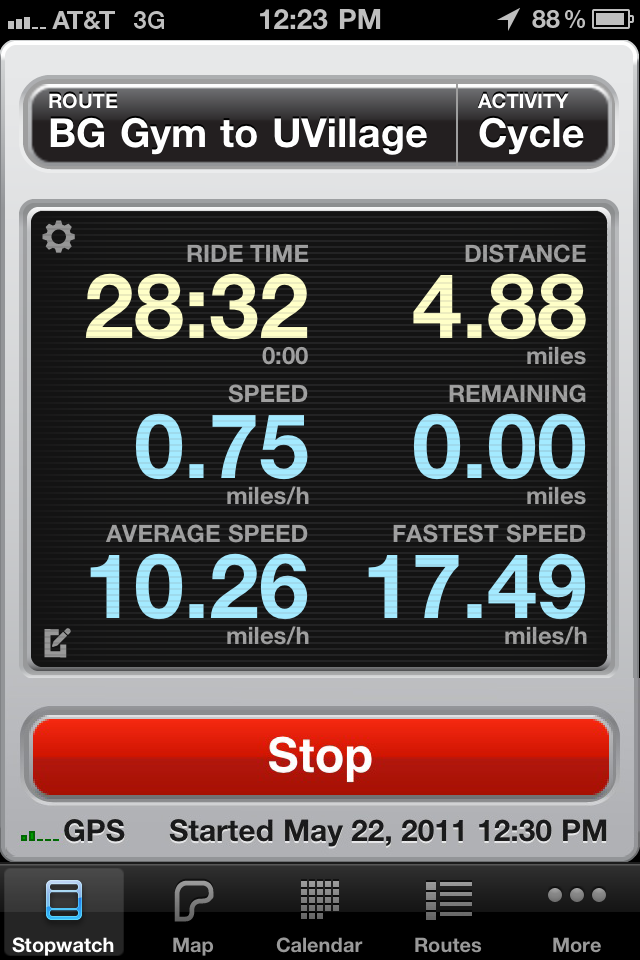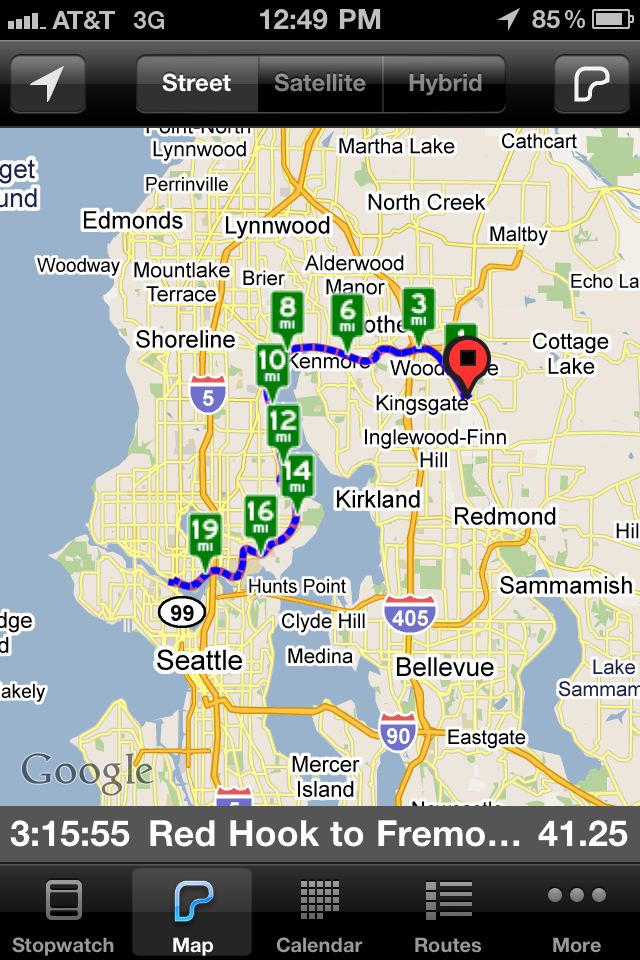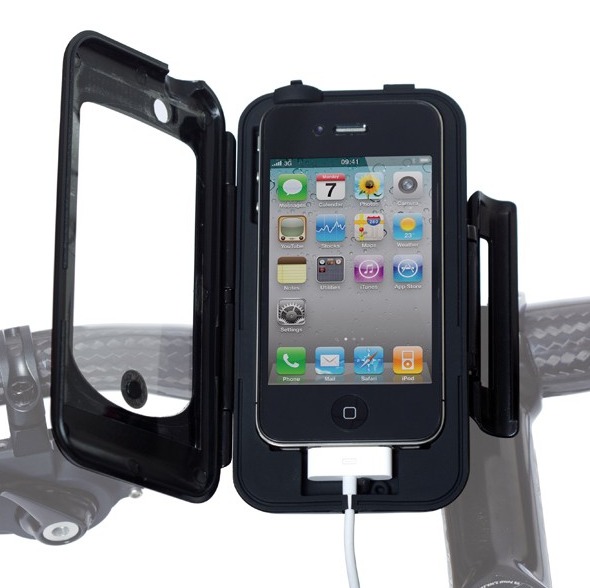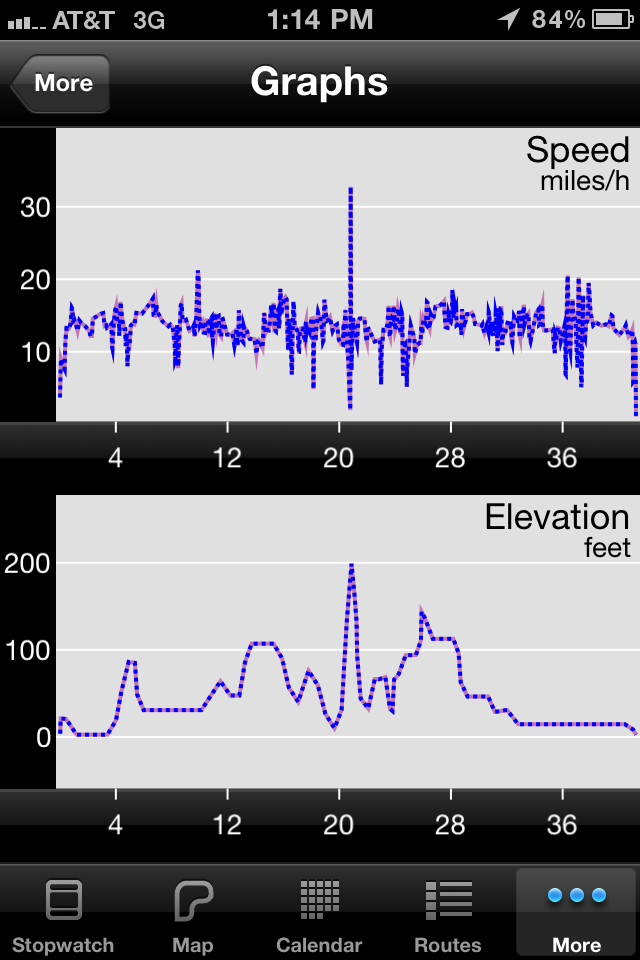Tracking a Rainy Ride with Cyclemeter
My iPhone rings at 7:00 AM on a wet Sunday morning, identifying the caller as a friend who’s joining me to do Haul Ash, a 42-mile bike ride between Seattle and Woodinville, WA to commemorate the eruption of Mount Saint Helens. It’s disappointing news: He and the other members of our group are backing out, choosing breakfast at a warm restaurant instead of several hours of riding in what turns out to be a record-setting rain storm.
Although I sometimes ride my bike to the office — a 9-mile round-trip route with a long hill on the return leg — I’m not a cyclist of the calibre of TidBITS Security Editor Rich Mogull, or our resident 100-mile-rider Tonya Engst (see “Find My (Wife’s) iPhone,” 23 September 2009). This 42-mile ride will be the longest single ride I’ve taken, after not being able to do the event the last couple of years due to scheduling conflicts.
Track My Ride — The long ride is a great opportunity for me to test out Abvio’s Cyclemeter iOS app ($4.99). Several years ago I bought a simple cyclometer that tracked my biking speed and distance. It communicated wirelessly with a sensor attached to the front wheel, but at some point the sensor’s battery died and I never got around to replacing it.
Now, of course, I have an iPhone with built-in GPS that is already with me when I ride. Cyclemeter collects that data, records my speed and distance, and logs the route. It can track activities other than cycling, too, ranging from cross country and downhill skiing, to hiking, skating, walking, and running.
When you open the app and give it permission to use your location data (just the first time you launch it), Cyclemeter takes a minute or so to lock onto a good GPS signal. From there, tap the large and obvious Start button to begin a stopwatch and the tracking.
The Stopwatch screen tracks your ride time and distance, current speed, average speed, and fastest speed. If you’ve ridden this route before (more on routes in a moment), you also see the remaining distance. You can customize the Stopwatch screen to display a host of other criteria, such as Split Speed, Direction, Current Time, and various odometers.
If you don’t want your ride dictated by numbers, a Map view plots your course onto a Google map, which can show the service’s street, satellite, or hybrid views. Every mile is marked, so you see more than just a dotted line.
In preparation for this ride, I had installed Biologic’s Bike Mount for iPhone 4 ($64.99), which clips the iPhone to the handlebars. The mount holds the iPhone in either horizontal or vertical orientation in a protective case. The touchscreen is still accessible, although not as responsive as using the screen by itself (which wasn’t a big deal — using a phone while riding, I’m sure, can be just as dangerous as when driving).
The one downside to the mount is that the case covers the iPhone’s ambient light sensor (although the phone’s cameras are still usable), so the screen dims almost immediately. That’s easily fixed by turning off the Auto-Brightness setting in the Brightness system preferences.
Biologic advertises the Bike Mount as being weather-resistant, with seals for the cameras, headphone port, and the sync cable. A silicone liner fits the iPhone 4 snugly; a liner for the iPhone 3G or 3GS is also included.
However, because of the forecast, I had earlier looked closely at the packaging and saw a small disclaimer that the case is designed to be splash-proof, and not to be used in heavy rain. Since that was exactly the type of weather expected for the ride, and because I’m not inclined to risk my iPhone in the name of science or journalism, I decide to slip the case into a pocket. Since my socks quickly become soaked within 15 minutes of riding, that turns out to be a good call. (And of course I wasn’t able to locate the
waterproof shoe covers I bought for just such an occasion. Ah well, once you’re wet, you’re wet, I suppose.)
With Cyclemeter running, I can concentrate on the ride itself. The route is practically flat and not difficult, and the rain seems to have convinced a lot of participants to go have breakfast instead. I can’t compare to previous years, but for some stretches I cycle alone, occasionally getting passed by faster riders.
At the halfway point in the Fremont neighborhood, I tap the Stop button in Cyclemeter to pause the stopwatch. There’s a gathering at a bar where riders can redeem drink tickets for beers (the ride is sponsored by the Red Hook Brewery, so of course there’s beer), but being an admitted alcohol lightweight, I pass. No sense in me wobbling off the trail. Instead, I put on a dry pair of socks (my best idea of the day), eat an energy bar, refill my water bottle and get on the trail heading back. A tap of Cyclemeter’s Start button and off I go for another 21 miles of rain and revolutions.
One of the advantages of the weather, for me, is that I resist the urge to check Cyclemeter every few minutes to see how far I’ve traveled. If I had put the iPhone into the bike mount, I could turn off the screen, but its data would be a quick button press and finger swipe away. I recognize landmarks that I passed on the way, but I’m finding it more enjoyable to just ride and experience the moment. I spend enough time in front of screens — laptop, iPad, and iPhone — during the week that it’s good for my eyes to absorb non-pixelated surroundings.
At one point, though, as my legs start to get tired, I finally pull the iPhone out of my pocket. Only four miles to go! A headwind has picked up, but discovering that I’m closer to the end than I expected gives me a boost of adrenaline to pedal a little harder and ignore my burning muscles.
I round a series of bends that culminate in a sharp right turn onto a bridge, and just beyond I can hear the voices of people who have already finished the ride, seeking dry refuge under tents and drinking beers at the brewery. There’s no finish line — it wasn’t a race — so I pedal to my car and tap Cyclemeter’s big red Stop button.
Now I can see that I’ve ridden 41.25 miles, and it took me 3:15:55 to do it (a bit faster than I expected, since I wasn’t trying to set any land speed records), for an average speed of 12.63 miles per hour. Tapping the More button at the bottom of the screen reveals a Graphs option, letting me see my speed and a representation of the ride’s elevation. I also have plenty of remaining battery life on the iPhone, about 60 percent, suggesting that the app grabs GPS data at a decent rate, but not so fast that it drains the battery.
(The faster you’re travelling, the faster the iPhone’s GPS has to sample to provide updated location information, which is why using a GPS navigation app in the car drains the iPhone’s battery much faster than using one on foot or on a bike.)
My wife wasn’t able to go on the ride this time, but wants to do the course later. So, I tap the Route button to save this route. When we go, preferably when it’s warm and dry, I’ll be able to load the route and start a new stopwatch, and then be able to compare results.
Share My Ride — Later, when I’m dry and recovered, I’m able to explore Cyclemeter’s sharing features. After all, what’s the point of racking up data if I can’t boast about it online? Maybe my friend, at this point full of hash browns and bacon, suspects that I spent the morning drinking at the brewery instead.
With Cyclemeter, I can share results to Twitter, Facebook, or Dailymile, or via email. However, the default options after you sign in to the corresponding services are too intrusive for my taste: The app can automatically post updates, and two of the six options are enabled. That’s two too many for me — I hate apps that automatically send anything, but at least it was easy to configure the settings (tap the service name, tap Auto Post Settings, and turn the options off). I don’t use Dailymile, so I didn’t test that option, but I’m assuming it’s similar. That said, I can see how the automatic post feature could be appealing if you’re on a long ride and you want to let friends or
family members keep track of where you are.
When you view the route info, scrolling down reveals a Share option that leads to a screen with a block of text filled in with the ride details. Tap the text to post it. The result is a link that displays a map of the ride on Google Maps, with mile markers and average speed per mile.
Sharing works the other way, too. You can enable the app to check your Facebook, Twitter, or Dailymile account. When something new is posted to your Twitter stream, for example, the app will read the text to you. You can also configure it so that only replies to you are read. It’s an opt-out feature, instead of opt-in, something I learned unexpectedly when someone posted to my Facebook wall. One voice is available for download at no charge, or you can purchase others in English (American and British English), French, German, and Italian.
Unfortunately, listening to tweets read aloud is like hearing a joke from someone who’s forgotten all the details (or having Jay Leno read tweets on TV, a feature I actually saw once while flipping channels). It doesn’t translate well to spoken communication, such as “Very funny. El. Oh. El. Hash sign. El. Ay. Em. Ee.”
Call me not-so-old-fashioned, but I don’t want to hear my Twitter stream while I’m riding. I’m wary of listening to music, even, although I’m more comfortable doing it while riding on a bike path like Seattle’s Burke-Gilman trail. Commuting in traffic? Forget it. I suppose if you have a daily biking or walking commute and want to catch up with what’s being said, and can parse the audio text, this is a fine feature. I catch up on Twitter by reading on my iPad when I take a bus to work — but I’m also not simultaneously driving the bus. As such, the feature falls outside my interest.
Another feature that doesn’t appeal to me is Competitors, where you can import rides from other Cyclemeter users and then compare your results with theirs, even during the ride. They can export the data as a Google Maps URL, a GPX (GPS Exchange Format) file attachment or URL, a KML (Keyhole Markup Language) file attachment or URL, or CSV (comma-separated values) file attachment or URL. I suppose I’m not competitive enough, but I can see how it would be helpful to try to match or exceed someone else’s pace.
Anticipate My Rides — Now that I have a reliable way to track my rides, I’m looking forward to using Cyclemeter and the Bike Mount for iPhone 4 more as the weather in Seattle improves. Pedaling for 42 miles in heavy rain has made me more confident to take on other rides. And I can say “I did it” to my friend, with the data to back it up, and convince him to join us later in the summer.




That was a brutal weekend for weather. I'm impressed that you made it out and finished.
Thanks for the detailed review. Do you a feeling for how Cyclemeter would work with intermittent tree cover (typical of, say, mountain biking)?
Sorry, I don't have a sense of how tree cover would affect it.
Tree cover can hinder the GPS signal.
The apps I use (Jog Log, MotionX-GPS and RunKeeper) show similar GPS data gaps when I am cycling. But I have to add that I've never experienced GPS loss when running.
Perhaps this has something to do with speed, 15 km/hour while running, 40 km/hour while cycling.
I use Cyclemeter for my rides, most of which are on singletrack. It works surprisingly well, even under the canopy of trees.
The interface appears identical to Runmeter. Assuming it's the same software but with a different name then it deals with trees quite well. Tall buildings or even the moderate ones of northern Manhattan not so well. In some places I have an amazing ability to run through blocks of buildings.
Are you going to post your Fremont solstice ride June 18?
I don't have the courage to do the Fremont Solstice ride. It's not the distance... it's the traditional lack of clothing. :-)
The costuming isn't keeping me out of Solstice. Rather it's the lack of a bike and the fact that I haven't ridden since about 1972, so I'd be a danger to myself, other cyclists, and the vast crowds. And walking is too slow and frowned upon.
Congratulations that you did the ride;-) And I like the idea that you enjoyed it despite the bad weather. As a passionate cyclist I can say there is no better way of exploring a countryside or small parts of a country than cycling through it... It is a real disadvantage that the battery life of an iPhone is that short. Therefore, I would like to know whether you can charge the iPhone while cycling? On the picture it looked like you could...
The app seems to have about the same functionality as Runtastic, a comparison would be interesting!
I used Cyclemeter last year when we rode from Brussels to London in July last year (3 days).
I can't really add that much to Jeff's review - it worked remarkably well and I'd certainly recommend it. I published my data live to a blog (mapmanuk.blogspot.com), which again worked well with people able to follow my progress in almost real-time, and that certainly generated interest and thus helped raise more sponsorship money.
The only downside was that the iPhone didn't have nearly enough battery life for a full days use. I had a couple of small, light, external iPhone batteries from Amazon (http://tinyurl.com/3mfqe24) which made sure I got a full 8 - 10 hours use.
Waterproofing was a simple re-sealable clear sandwich bag (and it worked ;-)
The only other thing to note was over £100 of phone data charges - but I'm sure most of that was posting photos from foreign countries.
This was a 3 hour ride, so I wasn't concerned about the battery. But for something longer, a Mophie Juice Pack or something similar would be essential.
I used it for the Solvang Century and it ran for over 6 hours using iPhone 4:
Route: 2011 Solvang Metric Century
Ride Time: 4:47:17
Stopped Time: 1:52:09
Distance: 70.41 miles
Average: 14.71 miles/h
Fastest Speed: 46.49 miles/h
Ascent: 2294 feet
Calories: 2805
I also like the fact it post to my calendar for workout tracking.
I use it for my blind stoker on my tandem and it reads out the data you select. Audible in low winds and little traffic - set volume to high.
It will also email updates to a contact, a feature good for security if riding alone or in suspicious areas.
Thanks for writing about your bike app experience, and the "damp" Bike Mount. I've actually been using MotionX GPS for years to track my bike trips, usually mounted on a RAM mount. I had to smile when you mentioned pushing a Stop button to interrupt your trip for lunch: MotionX has had auto-pause for quite a while. In fact, MotionX does many things very well, gets better with each frequent update, and is less expensive. I have no connection with MotionX, by the way; I'm just a very satisfied user.
As for riding (and tracking) in the rain: I usually pop my iPhone into a zip-lock bag and stick it into my Revelate Designs Gastank. Not so easy to operate, but I know it's still tracking.
How does it handle being forced to work in the background. For example, if you got a phone call, does it interrupt the tracking of your trip? Can you go to another program to look something up and return to a trip still tracking?
I'm running cyclemeter on my iPhone 4 in parallel with a Garmin 305 that's my normal cycling computer. It's good to have a backup!
I have observed that after running Cyclemeter my iPhone battery depletes very quickly unless I delete it from the list of active applications. When I forget to do this, all too often, I find my iPhone drops to 20% capacity remaining in the course of an afternoon.
I would miss the cadence and heart-rate information that my Garmin stores for me. I think it would do a double-century just fine which my Garmin would not, at least not at my speed!
Good job of riding on a seriously nasty day. They must have been filming "The Killing" when you were out there!
One thing I came across was a simple case for my iPhone called the iLoc. No longer do I need to worry about what to do with my phone if I'm out biking in the rain. You can get 2 for a buck at www.iLocStore.com